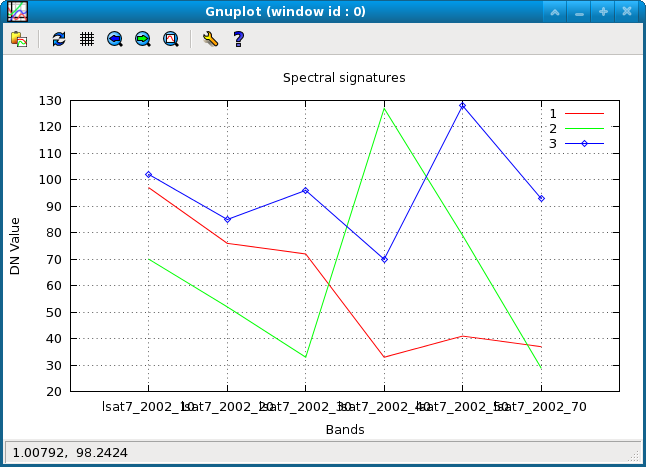i.spectral
Displays spectral response at user specified locations in group or images.
i.spectral [-cgt] [group=name] [subgroup=name] [raster=name [,name,...]] coordinates=east,north [,east,north,...] [output=name] [format=string] [--overwrite] [--verbose] [--quiet] [--qq] [--ui]
Example:
i.spectral coordinates=0.0
grass.script.run_command("i.spectral", group=None, subgroup=None, raster=None, coordinates, output=None, format="png", flags=None, overwrite=None, verbose=None, quiet=None, superquiet=None)
Example:
gs.run_command("i.spectral", coordinates=0.0)
grass.tools.Tools.i_spectral(group=None, subgroup=None, raster=None, coordinates, output=None, format="png", flags=None, overwrite=None, verbose=None, quiet=None, superquiet=None)
Example:
tools = Tools()
tools.i_spectral(coordinates=0.0)
This grass.tools API is experimental in version 8.5 and expected to be stable in version 8.6.
Parameters
group=name
Name of input imagery group
subgroup=name
Name of input imagery subgroup
raster=name [,name,...]
Name of input raster map(s)
coordinates=east,north [,east,north,...] [required]
Coordinates
output=name
Name for output image is valid for -g (or text file for -t flag)
format=string
Graphics format for output file (valid for -g flag)
Allowed values: png, eps, svg
Default: png
-c
Show sampling coordinates instead of numbering in the legend (valid for -g flag)
-g
Use gnuplot for display
-t
output to text file
--overwrite
Allow output files to overwrite existing files
--help
Print usage summary
--verbose
Verbose module output
--quiet
Quiet module output
--qq
Very quiet module output
--ui
Force launching GUI dialog
group : str, optional
Name of input imagery group
Used as: input, group, name
subgroup : str, optional
Name of input imagery subgroup
Used as: input, subgroup, name
raster : str | list[str], optional
Name of input raster map(s)
Used as: input, raster, name
coordinates : list[tuple[float, float]] | tuple[float, float] | list[float] | str, required
Coordinates
Used as: input, coords, east,north
output : str, optional
Name for output image is valid for -g (or text file for -t flag)
Used as: output, file, name
format : str, optional
Graphics format for output file (valid for -g flag)
Allowed values: png, eps, svg
Default: png
flags : str, optional
Allowed values: c, g, t
c
Show sampling coordinates instead of numbering in the legend (valid for -g flag)
g
Use gnuplot for display
t
output to text file
overwrite : bool, optional
Allow output files to overwrite existing files
Default: None
verbose : bool, optional
Verbose module output
Default: None
quiet : bool, optional
Quiet module output
Default: None
superquiet : bool, optional
Very quiet module output
Default: None
group : str, optional
Name of input imagery group
Used as: input, group, name
subgroup : str, optional
Name of input imagery subgroup
Used as: input, subgroup, name
raster : str | list[str], optional
Name of input raster map(s)
Used as: input, raster, name
coordinates : list[tuple[float, float]] | tuple[float, float] | list[float] | str, required
Coordinates
Used as: input, coords, east,north
output : str, optional
Name for output image is valid for -g (or text file for -t flag)
Used as: output, file, name
format : str, optional
Graphics format for output file (valid for -g flag)
Allowed values: png, eps, svg
Default: png
flags : str, optional
Allowed values: c, g, t
c
Show sampling coordinates instead of numbering in the legend (valid for -g flag)
g
Use gnuplot for display
t
output to text file
overwrite : bool, optional
Allow output files to overwrite existing files
Default: None
verbose : bool, optional
Verbose module output
Default: None
quiet : bool, optional
Quiet module output
Default: None
superquiet : bool, optional
Very quiet module output
Default: None
Returns:
result : grass.tools.support.ToolResult | None
If the tool produces text as standard output, a ToolResult object will be returned. Otherwise, None will be returned.
Raises:
grass.tools.ToolError: When the tool ended with an error.
DESCRIPTION
i.spectral displays spectral response at user specified locations in images.
NOTES
This script requires the launch of one of the supported monitors (cairo, png, ps) or gnuplot to be installed.
EXAMPLE
Analysis of LANDSAT TM7 channels (North Carolina dataset):
g.region raster=lsat7_2002_10 -p
i.spectral -g raster=lsat7_2002_10,lsat7_2002_20,lsat7_2002_30,lsat7_2002_40,lsat7_2002_50,lsat7_2002_70 \
coordinates=636069,215440,637958,223393,633277,223605

Spectral plot of 3 different land cover types: (1) water, (2) green
vegetation, and (3) highway
North Carolina sample dataset:
g.region raster=lsat7_2002_10 -p
LIST=`g.list type=raster pattern="lsat7_2002_[1-5,7]0" separator=","`
d.mon start=cairo output=plot.png
i.spectral raster=$LIST coordinates=637502.25,221744.25
d.mon stop=cairo
This will search all LANDSAT map for 2002 but select only the B, G, R, NIR, and MIR channels.
SEE ALSO
d.where, r.what, Cairo driver, PNG driver, PS driver (Postscript)
AUTHORS
Markus Neteler
Francesco Pirotti
SOURCE CODE
Available at: i.spectral source code
(history)
Latest change: Friday Mar 07 23:20:43 2025 in commit b94776a